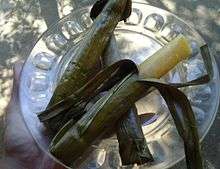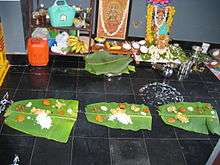Banana leaf


Banana leaves have a wide range of applications because they are large, flexible, waterproof and decorative. They are used for cooking, wrapping and food-serving in a wide range of cuisines in tropical and subtropical areas. They are used for decorative and symbolic purposes in numerous Hindu and Buddhist ceremonies. In traditional homebuilding in tropical areas, roofs and fences are made with dry banana-leaf thatch.[1] Banana and palm leaves were historically the primary writing surfaces in many nations of South and Southeast America.
Applications in cuisine

Banana leaves are large, flexible, and waterproof.[2] They impart an aroma to food that is cooked in or served on them; steaming with banana leaves imparts a subtle sweet flavor and aroma to the dish.[3] The leaves are not themselves eaten and are discarded after the contents are consumed.
Besides adding flavor, the leaves keep juices in and protect food from burning, much as foil does.[4] In Tamil Nadu (India) leaves are fully dried and used as packing material for foodstuffs, and are also made into cups to hold liquids. The dried leaves are called 'Vaazhai-ch- charugu' (வாழைச் சருகு) in Tamil. Some South Indian, Filipino and Khmer recipes use banana leaves as a wrapper for frying. The leaves are later removed. In Vietnamese cuisine, banana leaves are used to wrap foods such as cha-lua.
Like green tea, banana leaves contain large amounts of polyphenols, including EGCG.
Worldwide cuisine by country
In Indian cuisine
South Indian cuisine is usually served on a banana leaf. Especially in the South Indian states of Andhra Pradesh, Tamil Nadu, Karnataka and Kerala and in the Northern and Eastern parts of Sri Lanka. On any festive occasion the food must be served on or in a banana leaf, and a banana is part of the food served. In Maharashtra on many special occasions like Ganesh chaturthi, people eat off banana leaves. The Banana leaf is also used for wrapping, for etc., for fish which can than be steamed.
In Bengali cuisine, banana leaf is used to prepare Paturi, which is extremely tasty marinated and seasoned boneless fresh fish steamed and cooked inside a banana leaf and eaten on it. Commonly, Bhetki and Ilish are used in making Paturi.
In Indonesian cuisine


In Indonesian cuisine, banana leaf is employed in cooking methods called pepes and botok; the banana-leaf packets of food are steamed, boiled, or grilled on charcoal. Banana leaves are also used to wrap several kinds of snacks kue (delicacies), such as nagasari or kue pisang and otak-otak, and also to wrap pressed sticky-rice delicacies such as lemper and lontong.
In Java, banana leaf is also used as a shallow conical bowl called "pincuk", usually to serve rujak tumbuk, pecel or satay. The pincuk secured with lidi semat (small thorn-like pins made from the coconut-leaf midrib). The pincuk fit in the left palm, while the right hand is used to consume the food. It also functions as a traditional disposable take-away food container. The cleaned banana leaf is often used as a placemat; cut banana-leaf sheets placed on rattan, bamboo or clay plates are used to serve food. Decorated and folded banana leaves on woven bamboo plates are used as serving trays, tumpeng rice cones, and holders for jajan pasar or kue delicacies.
In Malaysian and Singaporean cuisine
In Malaysian and Singapore cuisine, banana leaves are used to wrap certain kuih and otak-otak. Malay foods such as nasi lemak are also commonly wrapped with banana leaves before being wrapped with newspaper, as banana leaves add fragrance to the rice.
In Philippine cuisine

Banana leaves are the traditional method of serving food in Philippine cuisine, with rice and other dishes laid out on large banana leaves (a salo-salo, reminiscent of a buffet) and everyone partaking using their bare hands (kamayan).[5][6] Another traditional method of serving food is by placing it on a banana-leaf liner placed over a woven bilao (a winnowing basket made of bamboo). The bilao is normally a farm implement used for removing chaff from grains, although there are now smaller woven trays or carved wooden plates of the same kind in Filipino restaurants used specifically for serving food.[7][8] Banana leaves are also commonly used in wrapping food (binalot), and are valued for the aroma they impart to the food.[9] Specific Philippine dishes that use banana leaves include suman and bibingka.[10][11]
In Polynesian cuisine
The Hawaiian imu is often lined with banana leaves.
In Caribbean and Mexican cuisine
Guanimos are Dominican tamales made with cornmeal, stuffed with ground meat and wrapped with banana leaves.
In Puerto Rico pasteles are made primarily with fresh green banana dough stuffed with pork, and then wrapped in banana leaves which have been softened at the fire. Many rice dishes in Puerto Rico are cooked with banana leaves as a lid to add flavor and aroma. Fish and pork shoulder can be wrapped in plantain leaves and baked. Guanimes known as Puerto Rican tamales, cornmeal cooked with coconut milk and other ingredients, are wrapped in banana leaves. Sweet cassava tortillas and Puerto Rican arepas are laid on banana leaves for a few hours before cooking.
Mexican, and more specifically Oaxacan tamales and a local variety of lamb or barbacoa tacos are often steamed in banana leaves. Banana leaves are used for wrapping pork in the traditional Yucatán dish Cochinita pibil.
In Central American cuisine

Vigorón' is a traditional Nicaraguan dish. It consists of a cabbage salad known as curtido (chopped cabbage, tomatoes, onions, and chile peppers marinated in vinegar and salt), boiled yuca, and chicharrones (fried pork with skin or with meat), wrapped in Banana leaf.[12] Variations of this dish are also found in Costa Rica.
Vaho (or Baho) is a mix of meat, green plantains and yuca cooked in banana leaves.

Nacatamal is made up mostly of nixtamalized corn masa (a kind of dough traditionally made from a process called nizquezar) and lard, but also includes seasonings such as salt and achiote (annatto). Filling consists of seasoned pork meat, rice, a slice of potato, bell pepper, tomato, onion, olives, cilantro and/or spearmint sprigs, and on occasion, though less commonly, capers, raisins or fresh chile (red or green), all wrapped in banana leaves. This dish is traditional to Nicaragua in Honduras.
In tradition and religion
Banana leaves are used by Hindus and Buddhists as a decorative element for special functions, marriages, and ceremonies in southern India and Southeast Asia. Balinese Hindu prepared banana leaf as the container for floral offerings called canang dedicated for hyang (spirits or deities) and gods. These floral offerings were placed in various places around the house.
In Thailand, banana leaf is used to create an offering bowl called called krathong, it is an important element during traditional festival of Loy Krathong day. Thai people will celebrate this on the full-moon day of the twelfth lunar month.[13] The celebration was meant to pay respect to the Mother of Water called Phra Mae Kong Kha by floating a krathong on a body of water.[14] Other Asian countries also shares this similar festival such as; Myanmar, Laos, Cambodia, India and China.[13] Krathong means lotus-shaped vessel like a leave bowl made of banana leaves and flowers with joss sticks and a candle in the middle. During Loy Krathong festival, people carry their krathongs to the river. After lighting candles and three joss sticks and making a wish, they will gently place their krathongs on the water and let them drift away.[13] People believed that krathongs will carry their wickedness and bad luck away, and after that happiness will come to them. In fact, it is the time to be happy as the sufferings are floated away and a time to enjoy dancing, singing, or activities with other people. People use banana leaves to make krathongs because it is organic material, natural and would decompose easily.[14]
As a writing surface
Banana and palm leaves were historically the primary writing surface in many nations of South and Southeast Asia. This has influenced the evolution of their scripts. The rounded letters of many of the scripts of southern India (such as Oriya and Sinhala), of Burmese, and of Javanese, for example, are thought to have been influenced by this: Sharp angles and tracing straight lines along the vein of the leaf with a sharp writing implement would risk splitting the leaf and ruining the surface, so rounded letters, or letters with straight lines only in the vertical or diagonal direction, were required for practical daily use.[15]
In such situations, the ribs of the leaves function as the dividing lines of ruled paper, separating lines of text. It is believed that this was so influential in the development of the rongorongo script of Easter Island that the more elaborate wood tablets were fluted to imitate the surface of a banana leaf.[16]
See also
- Patravali, a dried leaf eating plate
- Banana leaf rice
- Strelitzia, a bird of paradise plant with similarly shaped leaves.
- Cochinita pibil, a Yucatán Mexican dish that wraps pork in banana leaves.
- Puto, Bibingka, and Suman, Filipino rice cakes which are traditionally wrapped in banana leaves.
References
- ↑ Molina, A.B.; Roa, V.N.; Van den Bergh, I.; Maghuyop, M.A. Advancing banana and plantain R & D in Asia and the Pacific. p. 84.
- ↑ Frozen Banana Leaf, Temple of Thai Food Store
- ↑ Black Cod Steamed in Banana Leaves with Thai Marinade, Frog Mom
- ↑ "Banana". Hortpurdue.edu. Archived from the original on 15 April 2009. Retrieved 2009-04-16.
- ↑ Elizabeth Ann Quirino (16 December 2014). "Have Filipino food, will travel". Inquirer. Retrieved 6 January 2015.
- ↑ Margaret Littman. "Authentic Filipino Food Comes to Nashville for One-Night SALO Project Pop-Up". Nola Defender. Retrieved 6 January 2015.
- ↑ "What I Ate @ Eureka (Palmeras)". The Hungry Giant. 5 January 2012. Retrieved 6 January 2015.
- ↑ "Uses of Bilao, Round Bamboo Tray". Luntian Laboratory. Retrieved 6 January 2015.
- ↑ Rowena Dumlao-Giardina (28 October 2014). "Savor the Philippines with this lunch wrapped in banana leaves". SheKnows. Retrieved 6 January 2015.
- ↑ Maan D'Asis Pamaran (22 December 2014). "Christmas: It's really more fun in the Philippines". Manila Standard Today. Retrieved 6 January 2015.
- ↑ Vanjo Merano (27 December 2010). "Suman sa Lihiya". Panlasang Pinoy. Retrieved 6 January 2015.
- ↑ http://www.whats4eats.com/vegetables/vigoron-recipe
- 1 2 3 Department of Cultural Promotion, Ministry of Culture (October 2014). "ลอยกระทง" (PDF).
- 1 2 Seamlaem, S (10 May 2011). "ภูมิปัญญาไทยกับงานใบตอง".
- ↑ Sanford Steever, 'Tamil Writing', in Daniels & Bright, The World's Writing Systems, 1996, p. 426
- ↑ Barthel, Thomas S. (1971). Pre-contact Writing in Oceania. Current Trends in Linguistics. 8. Den Haag, Paris: Mouton. p. 1169.
_Sunda.jpg)


